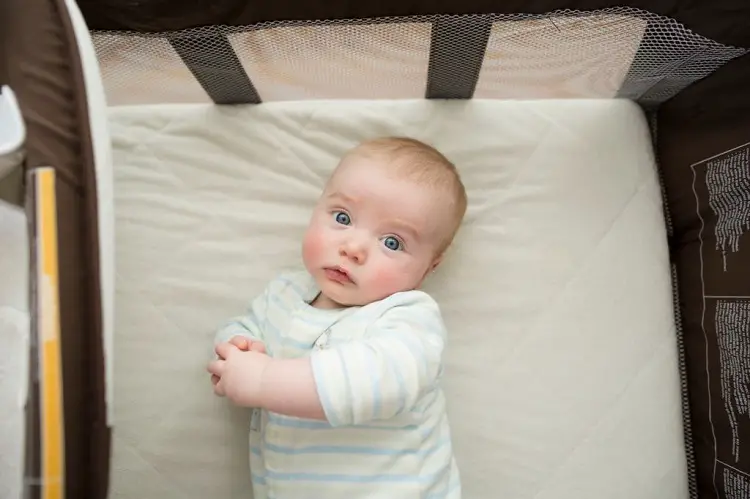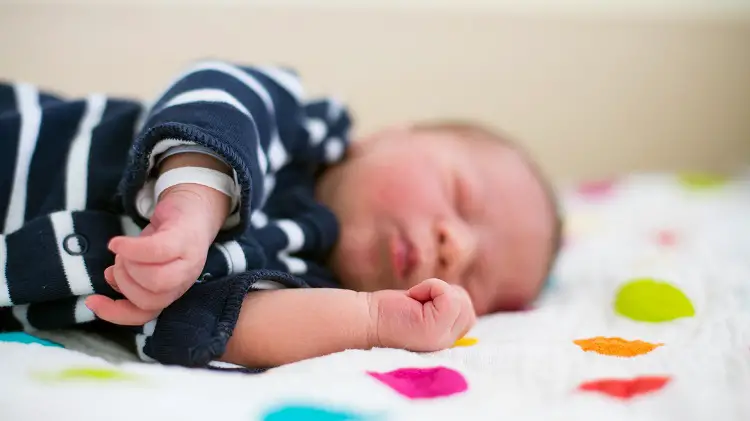A pack n play is a must-have item on every baby registry. It gives parents a breather while their little one is happily occupied playing in a safe and secure environment.
You can use this item for naps around your home, take them with you on visits to Grandma’s house, or even use them for room sharing with your little one.
To tell you the truth, this item is a godsend for most parents, but the common question is, How long can baby sleep in pack n play, why do I need it, and is it safe for baby?
In this article, we’ve gathered all the information you need to know about using pack-n-play for your baby, and certainly, it’s safe up to a certain age. Read On…
What Is A Pack N Play?
A pack n play is a multifunctional small, enclosed area fitted with a mattress where your baby can play and nap. Some are built with a wooden frame, and others have a metal frame with mesh walls. This enclosed environment is not similar to a playpen.
Usually, playpens don’t come with a mattress; it’s just a fence that’s put directly on the floor. It is also different from the bassinet. Bassinets are small beds for newborns and babies up to 3 – 4 months.
Pack n plays can be collapsed and taken with you easily when traveling. This makes it perfect for babies and toddlers. Most pack n plays have a weight limit of 30 lbs, but it will vary from one model to another.
Benefits Of A Pack N Play
Some models of Pack n plays are built-in with a detachable bassinet and a changing table that clips to the top rail. In this way, when you purchase a play yard, you can use it right from the day you bring your little one home.
And also, you can keep using the changing table as an alternate place to do your diaper changes. A pack n play is a safe and controlled environment to put your newborn. The sides are sufficiently high, so your baby can’t climb out of it.
It is also an environment for your baby to sleep and play when you are otherwise occupied. A pack n play is portable. This means your baby can sleep in a recognizable environment even when you go to visit your family or away for the weekend.
Some parents use the pack n play in their bedroom for the first 6 months and afterward move it to the baby’s room. When shopping for pack n play, look out for one that is lightweight and easy to assemble.
Some brands can be a bit heavy and bulky. You can get an affordable lightweight pack n play on Amazon.
Read Also: How To Set Up Graco Pack n Play Mattress
How Long Can Baby Sleep in Pack N Play? Everything You Need To Know

The best places to turn to for reliable answers are the APA (American Psychological Association) and the manufacturer of the item you’ve purchased (or still considering). Each company has its own recommended weight and height limits, and even these can vary from model to model.
Generally, babies can stop sleeping in their pack n play once they weigh about 30 pounds, 35 inches in height, or somewhere between 2 and 3 years of age. Also, a baby might not weigh 30 pounds but might be too tall for his age.
This means the baby may be able to climb out of his/her pack n play or possibly too tall to lay comfortable in it. Therefore, check your baby’s height and see if he measures close to 35 inches. If he does, it’s time to move him out of his pack n play.
Also, some babies are too strong and can become stubborn when their movements are restricted. Just ensure, regardless of his weight or length, that your baby is not too strong to topple the pack n play over.
Additionally, that’s also a sign that it’s time to switch his sleeping arrangements. Just watch how your baby behaves when inside the pack n play. His/her behavior will give you all the information you need.
Read Also: When Is Baby Too Big For A Bassinet?
What Position Is Best For Baby To Sleep In?
According to the AAP (American Academy of Pediatrics), babies should always be placed on their backs to sleep to reduce the risk of SIDS (Sudden infant death syndrome).
In the United States, SIDS is responsible for more deaths in babies in the first year of their life than any other cause. At one time, physicians suggested babies sleep on their stomachs or sides to improve conditions like reflux, but reports have shown that the back is the safest position for sleeping.
While we aren’t entirely sure why, scientists believe that a baby sleeping on the stomach or side may obstruct the upper airway, rebreathing carbon dioxide (decreasing oxygen levels), or can cause overheating.
Around six months, many infants begin to roll over and may end up sleeping on their stomachs or sides. If your baby is rolling, keep placing him on his back to sleep at night and for naps. But if he rolls over in his sleep, don’t worry about repositioning.
Other Frequently Asked Questions
Are Pack N Plays Safe For Sleep?
Yes. Remember that there are two different places you could technically put your baby to sleep in; the newborn napper (bassinet) or the main pack n play area.
However, there are some caveats to remember when it comes to general play yard sleep safety. According to the American Academy of Pediatrics (AAP), parents must ensure that the mattress their baby will be sleeping on is firm.
Several reports have shown that soft or loose bedding is not safe for babies. It is best advised to remove all crib bumpers, blankets, pillows, and soft toys if you leave your child unattended for any time.
Leave the sleeping environment bare and use only fitted sheets specially designed for your pack n play make and model. Third-party sheets that don’t suit the exact size of your pack n play may come loose or bunch up causing a suffocation hazard.
Make sure the pack n play mattress you are using is clean, thin, and firm. I have a great post on how to clean pack n play mattress pads. The sides of the pack n play should permit adequate air to come in.
Ideally, the pack n play should have breathable mesh sides, which are standard for most manufacturers. Remember always put your baby to sleep on his/her back. According to the AAP, this position is the best way to avoid SIDS (Sleep-Related Infant Deaths Syndrome).
When assembling the pack n play, ensure you gather it properly and lock the sides incorrectly. Some playards like Graco are very easy to assemble, but some require multiple steps.
Make sure that each piece of the playard is locked into place correctly before putting the baby in it to play or sleep.
Read Also: Easy Steps On How To Assemble Graco Pack N Play
Is Pack N Play Safe For Baby To Sleep In Every Night?
Pack n play is safe for sleep as long as all other safety guidelines are followed correctly. Whether you use it once in a while or every night, follow all the sleep safety guidelines already mentioned here.
However, you should remember that pack n plays are not meant to be used every night. Pack n play is meant for travel and daytime play. With the added usage your pack n play may begin giving indications old enough speedier than expected.
With this in mind, always check for the structural integrity of your pack n play to ensure your baby’s utmost safety.
Read Also: How To Make A Pack N Play More Comfortable
What About Sleeping In An Attached Bassinet?
During early newborn days when you don’t want to let your newborn out of sight, using an attached bassinet can be a lifesaver, especially during those midnight feeding sessions.
The most important considerations with these attachable items are to make sure that you practice the safety guidelines (like properly securing to the playard) and stop using once your baby has outgrown the maximum recommended weight (usually 15 pounds).
Should I Add Extra Bedding?
Are you worried about keeping your baby cozy and warm? According to the APA (American Psychological Association), there should never be any blankets, pillows, or toys where your baby sleeps.
All of these items can threaten babies and increase the risk of SIDS. Playards also don’t need any additional mattresses beyond what comes included. Adding any extra mattress could leave space for your baby to become entrapped.
It is best advised to allow babies to sleep on firm surfaces, such as a crib, playard, or bassinet. If you’re worried about your baby becoming cold, you can consider using a safety-approved swaddle blanket like (SwaddleMe) or maybe a sleep sack.
These safety-approved wearable blankets can be worn over your baby’s onesie or pajamas to add a layer of warmth for cooler temperatures.
Remember that the best room temperature for a baby is between 65 and 72 degrees Fahrenheit to prevent overheating.
Related Posts:
Conclusion
We hope this article answers your question how long can baby sleep in pack n play? Owning a pack n play is like a rite of passage into parenthood for most new moms and dads. This portable item can be used for sleep, play, and even changing diapers!
Being portable means they’re perfect for small spaces and parent’s on-the-go. Keep in mind that when you fit your pack n play with a firm mattress and a tight-fitting sheet, you meet all safety requirements of the AAP.
Regardless of whether your baby is using his/her pack n play for the occasional nap or room-sharing at night, he/she should be safe and secure as long as you follow the recommended rules on weight/height and use.
